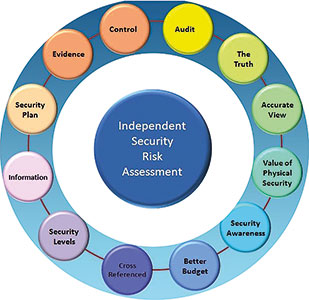
Risk is defined as the probability of threat of damage, injury, liability, loss or any other negative occurrence that is caused by external or internal vulnerabilities, and that may be avoided through pre-emptive action. (Reference: business directory.com.)

Therefore, the security risk assessment is the critical tool required to identify, understand, research and develop your security plan. The security risk assessment should be structured in such a way that it provides sufficient information from development to occupation and management of the estate.
The developer needs to consider the security requirements of the estate in the initial design phase of the project and imbed as many security features as possible into the original design concepts, prior to construction. As retrofitting is a very expensive and unsightly, effective planning saves cost further down the line as the security infrastructure can be plugged into and expanded upon as required. It is the responsibility of the developer to create the framework for a secure environment for the residents and an efficient system, that eliminates the opportunity for crime to occur and one that can be easily maintained by the estate management. In a competitive world and especially in the South African context, security is proving to be a marketable differentiator.
The potential and existing homeowner should request a copy of the estate security risk assessment and where possible the assessment specific to their own unit within the estate to contextualise and assess their own internal vulnerabilities and risk, as well as within the surrounding macro environment. In addition, a qualified risk assessment often results in a higher selling price and faster sale for owners looking to sell their properties.
What if?
Estate management, being managing agents, boards of trustees, body corporates, estate and security managers need to understand and have an unbiased and truthful perspective as to their current security status, vulnerabilities and requirements, from both an internal and external perspective. Therefore, the objective of the security risk assessment must be to answer the question: What if?
A quality security risk assessment should identify and quantify the probability of incidents occurring, based on the clear identification of the opportunities present. These opportunities need to be evaluated on their individual merit and the risk quantified in context of all combined risk factors.
The current industry norm, to use the fixed grading matrix system, which is utilised to establish health and safety, business enterprise, asset and IT/electronic risk, cannot be used as the norm or standard to identify specific security risk and is therefore simply an incorrect practice, which can lead to serious injury, loss and liability. Any security risk assessment that is presented with this as its founding principle should be questioned.
It is important to be able to identify the differences between an independent security risk assessment and the current industry risk assessment as presented, known as a product assessment.
It is common practice to accept a free risk assessment prepared by a potential security service provider, whose sole aim is to limit their own liability and to promote and sell their own products and solutions for profit. Further it is unreasonable to expect ones existing service provider to do a security risk assessment and produce an unbiased and impartial report that may impact upon their contracts.
An independent security risk assessor may recommend solutions and possible products to satisfy the recommendations, yet does not earn commission on, nor profits from the implementation of the solutions.
An independent security risk assessor is a consultant, whose sole aim is to identify crime opportunities and vulnerabilities and provides options for remediation and mitigation, and one who charges for their service based on their experience and expertise on a time cost basis. The client and circumstance are paramount and are the primary focus of an independent contractor.
Estate / security manager
This raises the question from an estate management perspective, can an estate and /or security manager do a security risk assessment? The simple answer is yes. However this practice is not advised as an integral part of the independent security risk assessment process is evaluating internal risk and all employees and management should be subject to the same levels of scrutiny to ensure the highest levels of transparency.
It is imperative that as an outcome of the risk assessment process, key performance indicators and accountability criteria are identified and become entrenched as an area of responsibility within the security and management portfolios. That being said, the same process offers protection to security and estate management alike.
As security cannot be regarded as a static element within estate management, the overriding goal of the security risk assessment must be to provide fresh insight into the current state of your implemented security, eliminate redundancy, as well as provide guidelines to ensure a solid foundation for the future.
The output
The outputs of the security risk assessment should answer a series of defined questions, address common mistakes and misconceptions and provide the information required in order to formulate the guidelines and structure of the security management plan for the estate, thereby putting you in control of your own security measures.
The security risk assessment process evaluates all external and internal factors and the standard approach is to assess the risk in a layered manner, from the outside to the inner sanctum. The risk assessment needs to take into account the various operational requirements of a residential estate and must be conducted during the day and the night, as well as during the week and weekend operations and holiday periods.
Infiltration testing is an integral part of the security risk assessment process.
Follow up risk assessments need to be undertaken at a minimum of three-year intervals and/or when there has been a security breach. Follow up random, unscheduled mini assessments should be considered as part of the security risk assessment contract and which provides efficiency testing of any new security measures and systems deployed.
The outputs of this evaluation that should be reported on in the risk assessment documentation are as follows, and the Alwinco Methodology is sited below.

Physical external evaluation
• Level 1 – Outside neighbourhood up to 1 kilometre from the estate boundary
• Level 2 – Property line – perimeter fencing and walls
• Level 3 – Driveway approach
• Level 4 - Access / egress position
Physical internal evaluation
• Level 5 – Common property
• Level 6 – Structural buildings within the common property
• Level 7 – Individual private properties
Service providers evaluation
• Level 8 – Security
• Level 9 – Maintenance and repairs
• Level 10 – Property and managing agents
Estate employees
• Level 11 – Security check and profiling
Security awareness evaluation
• Level 12 – Management policies and procedures
• Level 13 – Security plans
• Level 14 - Personal awareness
Therefore a qualified security risk assessment should be the primary input document utilised to inform the development, structure, format, budget and measurement criteria of the estate security plan and should be conducted by an industry independent professional that understands the requirements needed in order to fulfil the estate’s obligations and meet the safety and security expectations of the estate’s residents.
For more information contact Andre Mundell, Alwinco, +27 (0)62 341 3419, www.alwinco.co.za
| Tel: | +27 62 341 3419 |
| Fax: | 086 666 8050 |
| Email: | andre@alwinco.co.za |
| www: | www.alwinco.co.za |
| Articles: | More information and articles about Alwinco |
© Technews Publishing (Pty) Ltd. | All Rights Reserved.